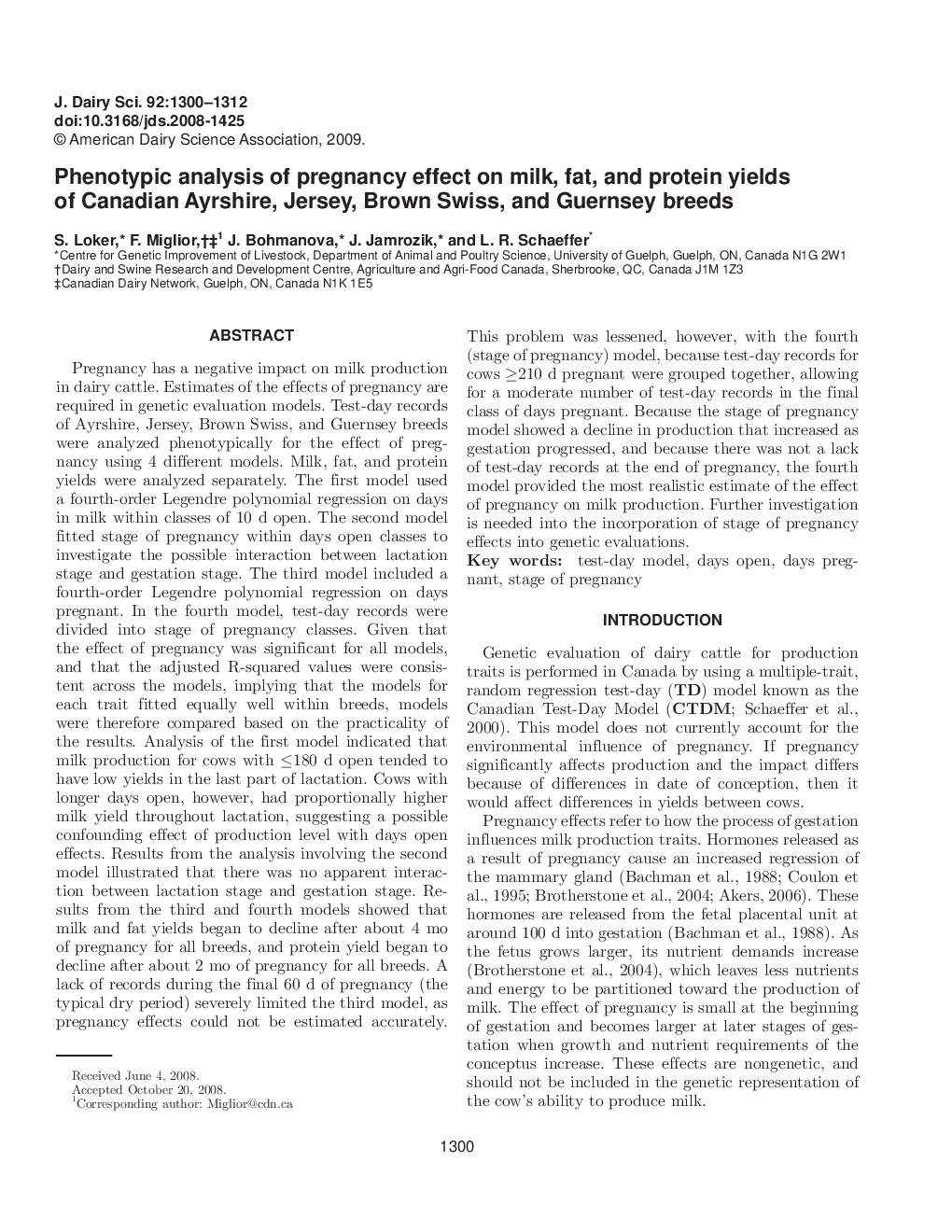| کد مقاله | کد نشریه | سال انتشار | مقاله انگلیسی | نسخه تمام متن |
|---|---|---|---|---|
| 2439885 | 1108106 | 2009 | 13 صفحه PDF | دانلود رایگان |
عنوان انگلیسی مقاله ISI
Phenotypic analysis of pregnancy effect on milk, fat, and protein yields of Canadian Ayrshire, Jersey, Brown Swiss, and Guernsey breeds
دانلود مقاله + سفارش ترجمه
دانلود مقاله ISI انگلیسی
رایگان برای ایرانیان
موضوعات مرتبط
علوم زیستی و بیوفناوری
علوم کشاورزی و بیولوژیک
علوم دامی و جانورشناسی
پیش نمایش صفحه اول مقاله

چکیده انگلیسی
Pregnancy has a negative impact on milk production in dairy cattle. Estimates of the effects of pregnancy are required in genetic evaluation models. Test-day records of Ayrshire, Jersey, Brown Swiss, and Guernsey breeds were analyzed phenotypically for the effect of pregnancy using 4 different models. Milk, fat, and protein yields were analyzed separately. The first model used a fourth-order Legendre polynomial regression on days in milk within classes of 10 d open. The second model fitted stage of pregnancy within days open classes to investigate the possible interaction between lactation stage and gestation stage. The third model included a fourth-order Legendre polynomial regression on days pregnant. In the fourth model, test-day records were divided into stage of pregnancy classes. Given that the effect of pregnancy was significant for all models, and that the adjusted R-squared values were consistent across the models, implying that the models for each trait fitted equally well within breeds, models were therefore compared based on the practicality of the results. Analysis of the first model indicated that milk production for cows with â¤180 d open tended to have low yields in the last part of lactation. Cows with longer days open, however, had proportionally higher milk yield throughout lactation, suggesting a possible confounding effect of production level with days open effects. Results from the analysis involving the second model illustrated that there was no apparent interaction between lactation stage and gestation stage. Results from the third and fourth models showed that milk and fat yields began to decline after about 4 mo of pregnancy for all breeds, and protein yield began to decline after about 2 mo of pregnancy for all breeds. A lack of records during the final 60 d of pregnancy (the typical dry period) severely limited the third model, as pregnancy effects could not be estimated accurately. This problem was lessened, however, with the fourth (stage of pregnancy) model, because test-day records for cows â¥210 d pregnant were grouped together, allowing for a moderate number of test-day records in the final class of days pregnant. Because the stage of pregnancy model showed a decline in production that increased as gestation progressed, and because there was not a lack of test-day records at the end of pregnancy, the fourth model provided the most realistic estimate of the effect of pregnancy on milk production. Further investigation is needed into the incorporation of stage of pregnancy effects into genetic evaluations.
ناشر
Database: Elsevier - ScienceDirect (ساینس دایرکت)
Journal: Journal of Dairy Science - Volume 92, Issue 3, March 2009, Pages 1300-1312
Journal: Journal of Dairy Science - Volume 92, Issue 3, March 2009, Pages 1300-1312
نویسندگان
S. Loker, F. Miglior, J. Bohmanova, J. Jamrozik, L.R. Schaeffer,